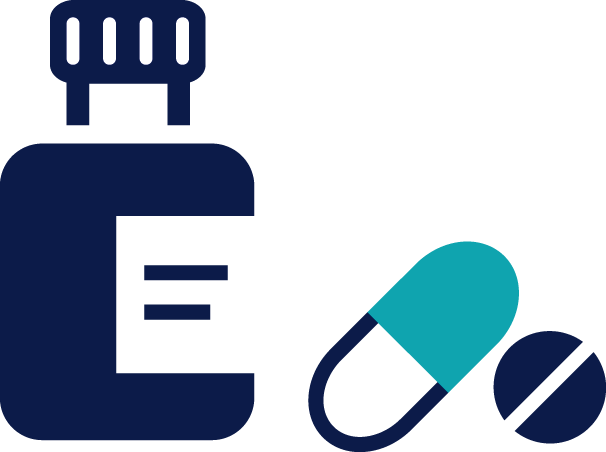Managing Erectile Dysfunction
What is erectile dysfunction and how is it treated?
Some treatments for prostate cancer, such as prostatectomy and radiotherapy, can cause damage to the nerves and blood vessels needed for an erection. Other treatments, such as hormone therapy, reduce the amount of testosterone in the body, which can reduce your sex drive and also lead to problems getting and maintaining an erection.
What is erectile dysfunction?
Erectile dysfunction can range from mild, where an erection may be possible but either the penis is not firm enough for sex or cannot be maintained, to severe, where an erection is not possible, either spontaneously or during sexual stimulation. It is possible for erectile function to improve following surgery but this can take between three months and three years. There are also many treatment options available. You will be able to speak to your doctor to decide which treatment is the most suitable for you.

Tablets
Drugs known as phosphodiesterase type 5 inhibitors or PDE5 inhibitors are one of the main treatments for erectile dysfunction following prostatectomy. Sildenafil citrate (Viagra) is an example of a PDE5 inhibitor as well as tadalafil (Cialis), vardenafil (Levitra) and avanafil (Spedra). PDE5 inhibitors increase the blood flow to the penis and some sexual stimulation is still needed for the erection. As a result, they may not work for those who are undergoing hormone therapy and have a decreased sex drive. PDE5 inhibitors also require nerve supply to work so they tend to be more effective in those who have undergone nerve sparing radical prostatectomy.
Tadalafil can then work for up to 36 hours, but sildenafil, vardenafil and avanafil work for four to six hours. This means that during this time, you should be able to get an erection following sexual stimulation.
Always tell your doctor about any other medication that you are taking, as PDE5 inhibitors must not be taken with nitrates. Nitrates are used to treat heart problems and are also found in some recreational drugs.
Injections
Penile injections are another option for treating erectile dysfunction if tablets do not work for you. The drugs used in the injections include alprostadil (Caverject or Viradil Duo) and aviptadil with phentolamine mesilate (Invicorp). They work by opening the blood vessels and increasing blood flow to the penis, directly causing an erection within 10 minutes of the injection. A doctor or nurse will teach you how to administer the injections. There may be some pain when the drug is injected but this is usually mild.
Pellets
Pellets are another way that the drug alprostadil can be prescribed and taken. The pellets are known as Muse and they are small and can be inserted into the tip of the penis using an applicator. Again, this should cause an erection within 10 minutes. Pellets can sometimes cause pain or a burning sensation in the penis.
Creams
Alprostadil creams (also known as Vitaros) are available on prescription. Similar to the pellets, the cream can be inserted into the tip of the penis with an applicator. It can take up to 30 minutes for the cream to have an effect. Cream can also cause pain or a burning sensation in the penis.
Seek medical advice as soon as possible if you have an erection that lasts for more than two hours. This can be a rare side effect of tablets, injections, pellets and creams.
Vacuum Pump
If medication does not work or is not suitable, a vacuum pump can be used. A plastic cylinder is placed over the penis and when the vacuum is applied, blood is sucked into the penis to give an erection. Once the penis is erect, a soft plastic ring called a constriction ring can be placed over the base of the penis to trap the blood and maintain the erection. The constriction ring should not be left on for longer than 30 minutes.
Implant
There is also the option of penile prosthesis, but this is usually only considered if other measures don’t work. It involves placing an implant in the penis during an operation. The most commonly used form of this treatment is inflatable implants. Two inflatable cylinders are implanted in the penis and connected to a pump placed in the scrotum. When you want an erection, you can squeeze the pump so that fluid is pumped into cylinders that expand to produce an erection. Semi-rigid rods are another form of implant. They are placed in the penis and can be bent or straightened so that the penis can be positioned up for an erection and down for when you don’t want an erection.
Lifestyle
Keeping active and maintaining a healthy weight can help to increase your sex drive and ability to get an erection. Smoking is known to be a factor in erectile dysfunction, so stopping smoking may also help.
Emotional Wellbeing
It can be difficult to talk about difficulties with getting an erection, but expressing how you feel may help you. You can talk to people that you know and trust, such as friends and family. Some people find it easier to talk to someone they don’t know, and your doctor or nurse may be able to refer you to a counsellor who can help you deal with the emotional impact of erectile dysfunction. Visit our page on emotional wellbeing here.
Support groups also offer valuable support and information. They provide a safe space to ask questions, share experiences and listen to others in a similar situation. This can help you to understand your own emotions and realise that you are not alone.
